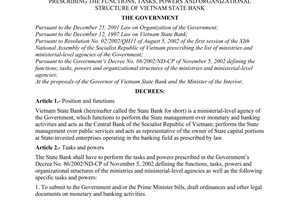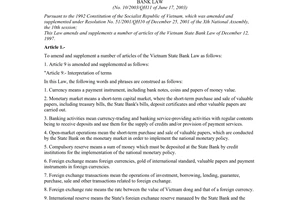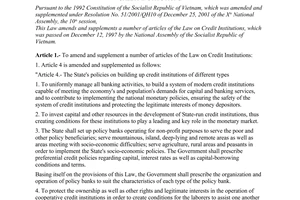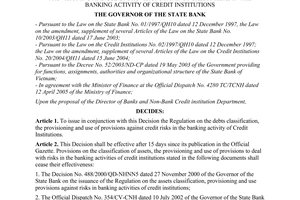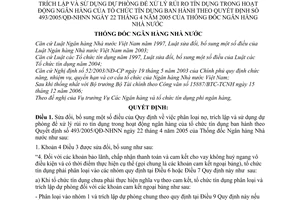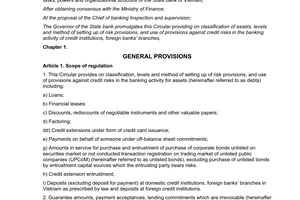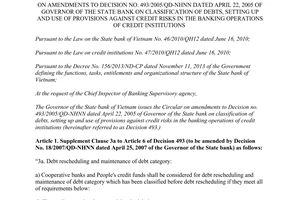Nội dung toàn văn Decision No. 18/2007/QD-NHNN of April 25, 2007, on amendment of and addition to a number of articles of the regulations on classification of debts, and establishment and use of reserves to deal with credit risks in banking operations by credit institutions, issued with Decision 493-2005/QD-NHNN of the State Bank of April 22nd, 2005
|
STATE
BANK OF VIETNAM |
SOCIALIST
REPUBLIC OF VIETNAM |
|
No. 18/2007/QD-NHNN |
Hanoi, April 25, 2007 |
DECISION
ON AMENDMENT OF AND ADDITION TO A NUMBER OF ARTICLES OF THE REGULATIONS ON CLASSIFICATION OF DEBTS, AND ESTABLISHMENT AND USE OF RESERVES TO DEAL WITH CREDIT RISKS IN BANKING OPERATIONS BY CREDIT INSTITUTIONS, ISSUED WITH DECISION 493/2005/QD-NHNN OF THE STATE BANK OF APRIL 22nd, 2005
THE GOVERNOR OF THE STATE BANK
Pursuant to the 1997 Law on
State Bank of Vietnam and the 2003 Law on Amendment of and Addition to a
Number of Articles of the Law on State Bank of Vietnam;
Pursuant to the 1997 Law on Credit Institutions and the 2004 Law on Amendment
of and Addition to a number of Articles of the Law on Credit Institutions;
Pursuant to Decree 52/2003/ND-CP of the Government dated 19 May 2003
stipulating the functions, duties, powers and organizational structure of the
State Bank of Vietnam;
With approval from the Minister of Finance in Official Letter 15887/BTC-TCNH
dated 15 December 2006; On the proposal of the Director of the Department for
Banks and Non-Banking Credit Institutions,
DECIDES:
Article 1. To amend and supplement a number of articles of the Regulations on classification of debts, and establishment and use of reserves to deal with credit risks in banking operations by credit institutions, issued with Decision 493/2005/QD-NHNN of the State Bank dated 22 April 2005 as follows:
1. To amend and add to clause 4 of article 3 as follows:
"4. With respect to guarantees, acceptances of payment and loan commitments which are irrevocable, unconditional and the timing for implementation of which is specified (hereinafter all referred to as off-balance sheet commitments), any credit institution must classify them into the groups stipulated in article 6 or 7 of these Regulations as follows:
(a) When the credit institution has not been required to perform any obligations in accordance with undertakings, it shall conduct a classification of and establish a reserve for the off-balance sheet commitments as follows:
- [Such commitments] shall be classified into Group 1 and a general reserve shall be established in accordance with article 9 of these Regulations if the credit institution assesses its clients are able to fully perform their obligations in accordance with undertakings;
- [Such commitments] shall be classified into Group 2 or a higher group depending on the assessment of the credit institution and a specific reserve or general reserve shall be established in accordance with articles 8 and 9 of these Regulations if the credit institution assesses its clients are not able to perform their obligations in accordance with undertakings.
(b) When the credit institution is required to perform its obligations in accordance with undertakings, it shall classify payments for guarantees and payments for acceptances of payment into the debt groups stipulated in article 6 or 7 of these Regulations with the number of overdue dates calculated from the date the credit institution performs its obligations in accordance with undertakings as follows:
- [Such payments] shall be classified into Group 3 if they are overdue for less than thirty (30) days;
- [Such payments] shall be classified into Group 4 if they are overdue for a period of between thirty (30) days and ninety (90) days;
- [Such payments] shall be classified into Group 5 if they are overdue for ninety one (91) days or more.
The credit institution shall conduct the classification in accordance with the following principle: payments for guarantees and payments for acceptances of payments shall be classified into a debt group with the level of risks equal to or higher than the debt group to which guarantees and acceptances of payments were previously classified in accordance with clause 4(a) of this article.
2. To add clause 3 to article 4 as follows:
"3. Every six months, credit institutions shall submit written reports to the State Bank (Department for Banks and Non-Banking Credit Institutions) on formulation of their internal credit ranking systems in accordance with clause 1 of this article, with the following particulars:
- Credit ranking system (comprising the ranking process and decisions on ranking results; credit- marking system; database system; and checking and controlling process);
- Status and schedule of implementation, proposed completion time, proposed time for pilot application and its results (if any);
- Issues to be currently dealt with;
- Other relevant contents."
3. To amend and add to article 6 as follows:
"Article 6
1. A credit institution shall carry out the classification of debts into five (5) groups as follows:
(a) Group 1 (standard) shall consist of:
- Debts not yet due and the credit institution assesses principal and interest as being able to be recovered in a full and timely manner;
- Debts which are overdue less than ten (10) days and the credit institution assesses the ability to fully recover principal and interest the repayment of which is overdue and the ability to fully and timely recover principal and interest within the remaining duration [of the restructured loan term];
- Debts classified into Group 1 in accordance with clause 2 of this article.
(b) Group 2 (special mention) shall consist of:
- Debts which are overdue for a period of between ten (10) days and ninety (90) days;
- Debts the repayment period of which is adjusted for the first time (in the case of a client being an enterprise or organization, the credit institution shall prepare a file on assessment of the ability of such client to fully repay principal and interest within the firstly adjusted repayment period);
- Debts classified into Group 2 in accordance with clause 3 of this article.
(c) Group 3 (sub-standard) shall consist of:
- Debts which are overdue for a period of between ninety one (91) days and one hundred and eighty (180) days;
- Debts the loan term of which is restructured for the first time, excluding debts the repayment period of which is adjusted for the first time and which are classified into Group 2 in accordance with clause 1(b);
- Debts interest of which is exempt or reduced due to the inability of clients to fully repay interest in accordance with credit contracts;
- Debts classified into Group 3 in accordance with clause 3 of this article.
(c) Group 4 (doubtful) shall consist of:
- Debts which are overdue for a period of between one hundred and eighty one (181) days and three hundred and sixty (360) days;
- Debts the loan term of which is restructured for the first time and which are overdue less than ninety (90) days in accordance with the first restructured loan term;
- Debts the loan term of which is restructured for the second time;
- Debts classified into Group 4 in accordance with clause 3 of this article.
(d) Group 5 (bad debts) shall consist of:
- Debts which are overdue three hundred and sixty (360) days or more;
- Debts the loan term of which is restructured for the first time and which are overdue ninety (90) days or more in accordance with the first restructured loan term;
- Debts the loan term of which is restructured for a second time and which are overdue in accordance with the second restructured loan term;
- Debts the loan term of which is restructured for a third time or more, including both debts which have not been overdue and debts which have been overdue;
- Frozen debts and debts awaiting to be dealt with;
- Debts classified into Group 5 in accordance with clause 3 of this article.
2. A credit institution may reclassify debts into the debt groups with a lower level of risks in the following cases:
(a) With respect to overdue debts, the credit institution shall reclassify such debts into the debt group with a lower level of risks (including Group 1) when the following conditions have been fully satisfied:
- Clients have fully repaid overdue principal and interest (including interest applicable to overdue principal) and principal and interest of subsequent repayment periods within at least six (6) months for medium and long term debts and three (3) months for short-term debts, from the date of fully repaying overdue principal and interest;
- Documents and files are available to provide evidence that the causes leading to overdue debts have been dealt with and remedied;
- The credit institution has sufficient grounds (supplementary information and documents) to assess that its clients are able to fully repay principal and interest within the remaining duration [of the restructured loan term].
(b) With respect to debts the loan term of which is restructured, the credit institution shall reclassify them into the debt group with lower level of risks (including Group 1) when the following conditions have been fully satisfied:
- Clients have fully repaid principal and interest in accordance with the restructured loan term within a period of at least six (6) months for medium and long term debts and three (3) months for short term debts, from the date of fully repaying principal and interest in accordance with the restructured loan term;
- Documents and files are available to evidence that the causes leading to the restructuring of the loan term of debts have been dealt with and remedied;
- The credit institution has enough grounds (supplementary information and documents) to assess that its clients are able to fully repay principal and interest within the remaining restructured term.
3. A credit institution must transfer debts to the debt group with a higher level of risks in the following cases:
(a) Total outstanding balance of a client in a credit institution must be classified into the same debt group. Where a client has two (2) or more debts to the credit institution, any of which has been classified into a debt group with higher level of risks than other debt groups in accordance with clause 1 of this article, the credit institution shall reclassify the remaining debts of such client into such group with the highest level of risks.
(b) With respect to syndicated loans, the credit institution acting as a co-ordinator shall classify debts of such syndicated loans in accordance with this article and must notify credit institutions making syndicated loans of the results of debt classification. Where a client borrowing syndicated loans has one or more other debts to a credit institution making syndicated loans and such debts have been classified into a different debt group other than the debt group to which the syndicated loans are classified by the credit institution acting as co-ordinator, the credit institution making the syndicated loans shall reclassify the total outstanding balance (including the outstanding balance of the syndicated loans) of the client borrowing syndicated loans into the debt group classified by the credit institution acting as co-ordinator or the debt group classified by the credit institution making syndicated loans, depending on which debt group has the higher level of risks.
(c) With respect to debts which are classified into any of the groups specified in clause 1 of this article, credit institutions shall proactively reclassify such debts into the debt group with the higher level of risks in accordance with the assessment of the credit institution when any of the following cases occurs:
- There appear adverse changes which cause negative impact on the environment and business sectors of a client;
- Debts of a client are classified into the debt group with a higher level of risks by other credit institutions (if such information is available);
- Financial indicators of a client (in relation to profitability, solvency, debt ratio on capital and cash flow) or ability of the client to pay debts keeps declining or has significant changes in a downward direction;
- The client fails to provide financial information in a complete, timely and honest manner at the request of the credit institution in order to assess the client's ability to pay debts.
4. The percentage for deduction to establish specific reserves for the five (5) debt groups stipulated in clause 1 of this article shall be as follows:
(a) Group 1: 0%,
(b) Group 2: 5%,
(c) Group 3: 20%,
(d) Group 4: 50%,
(dd) Group 5: 100%.
With respect to frozen debts awaiting to be dealt with by the Government, the credit institution shall establish a specific reserve in conformity with its financial capability."
4. To amend and add to article 8 as follows:
"Article 8
1. Amount of specific reserve for each debt shall be calculated in accordance with the following formula:
R = max {0, (A C)} x r
In which:
R: amount of specific reserve to be deducted. A: outstanding principal of a debt.
C: deducted value of security property.
r: percentage for deductions to establish a specific reserve.
2. Security property which is included for deduction on calculation of the sums of the specific reserve as stipulated in clause 1 of this article shall be required to fully satisfy the following conditions:
- Credit institutions shall have the right to put on a sale of security property in accordance with security contracts if their clients fail to perform any obligations in accordance with undertakings;
- The duration for putting on a sale of security property proposed by credit institutions shall not exceed one (1) year for security property not being real estate and two (2) years for security property being real estate, from the commencement of putting on a sale of such security property.
Where a security property does not fully satisfy the above-mentioned conditions or is not put on a sale, the deducted value of such security property (C) stipulated in clause 1 of this article shall be deemed equal to zero (0).
3. The deducted value of a security property (C) shall be determined by multiplying the deducted percentage stipulated in clause 4 of this article and:
- The market value of gold at the time of establishment of a specific reserve;
- Par values of Government bonds, Treasury bills, and valuable papers, excluding bonds of credit institutions and enterprises;
|
Type of security property |
Maximum deducted ratio (%) |
|
Balance on deposit accounts, savings books, valuable papers in Vietnamese dong issued by credit institutions |
100% |
|
Treasury bills, gold, balance on deposit accounts, savings books, valuable papers in foreign currencies issued by credit institutions |
95% |
|
Government bonds: - With a remaining term of one (1) year or less - With a remaining term of between one (1) year to five (5) years - With a remaining term of five (5) years or more |
95% 85% 80% |
|
Securities, negotiable instruments and valuable papers issued by other credit institutions and listed on a stock exchange or at a securities trading centre |
70% |
|
Securities, negotiable instruments and valuable papers issued by enterprises and listed on a stock exchange or at a securities trading centre |
65% |
|
Securities, negotiable instruments and valuable papers issued by other credit institutions but not yet listed on a stock exchange or at a securities trading centre |
50% |
|
Real estate |
50% |
|
Other types of security properties |
30% |
- The value of securities on the securities market issued by other enterprises and credit institutions and listed on a stock exchange or at a securities trading centre at the time of establishment of a specific reserve;
- The value of security property being securities issued by other enterprises and credit institutions but not yet listed on a stock exchange or at a securities trading centre, being chattels, real estate and other security properties stated in the most recent valuation minutes agreed by a credit institution and its client (if any) or stated in security contracts;
- The residual value of finance leasing assets calculated in accordance with a finance leasing contract at the time of establishment of a specific reserve;
- The value of a security property formed from the amount of loans corresponding to the amount of money disbursed in accordance with a credit contract at the time of establishment of a specific reserve.
4. The percentage deducted to identify the deducted value of a security property (C) shall be determined by credit institutions on the basis of the value recoverable from the sale of the security property after deduction of estimated expenses for sale of the security property at the time of establishment of a specific reserve, but shall not exceed the maximum deducted percentage stipulated below:
5. To amend clause 4 of article 11 as follows:
"4. After five (5) years from the date of use of reserves to deal with credit risks, credit institutions shall be allowed to write off debts the credit risks of which have been dealt with, from the balance sheet. With respect to State commercial banks, the write off shall be conducted only when complete files and documents are provided to prove that all measures were taken to recover debts but debts were not recovered and after this is approved in writing by the Ministry of Finance and the State Bank."
6. To amend and add to article 15 as follows:
"Article 15
Files used as grounds to deal with credit risks shall comprise:
1. Files on provision of loans and recovery of debts; files on discount and rediscount of negotiable instruments and other valuable papers; files on loan guarantees and commitments; finance leasing files; files on security properties and other relevant documents.
2. With respect to cases stipulated in clause 1 of article 10 of these Regulations, in addition to the files stated in clause 1 of this article, the following documents shall be required:
(a) With respect to clients being organizations and enterprises:
- Copies of the decision on declaration of bankruptcy from the Court or decision on dissolution from a competent State body in accordance with law;
- Copies of reports on implementation of the decision on declaration of bankruptcy and reports on terminating the implementation of the decision on declaration of bankruptcy from the office which enforces court judgments, and documents on settlement of debts of dissolved organizations and enterprises.
(b) With respect to clients being individuals:
- Copies of death certificates and missing certifications issued by a competent body.
3. With respect to the cases stipulated in clause 2 of article 10 of these Regulations, in addition to the files stated in clause 1 of this article, the following documents shall be required:
- Files and documents to be used as the grounds to classify [debts] into Group 5;
- Files and documents proving that credit institutions made great efforts and took measures to recover debts but failed."
7. Sample forms for report No. 1A, 1B, 2A and 2B shall be replaced by the sample forms for report
No. 1 and No. 2 (attached to this Decision).
Article 2. This Decision shall be of full force and effect fifteen (15) days after the date of its publication in the Official Gazette.
Article 3. The Head of the Office, the Director of the Department for Banks and Non Banking Credit Institutions, the Heads of entities under the State Bank, the Directors of the branches of the State Bank of provinces and cities under central authority, and the Chairman of the Board of Management, the General Director (Director) of credit institutions shall be responsible for implementation of this Decision.
|
|
GOVERNOR
OF THE STATE BANK OF VIETNAM |
SAMPLE FORM NO. 1
|
CREDIT INSTITUTION |
SOCIALIST
REPUBLIC OF VIET NAM |
REPORT ON
CLASSIFICATION OF DEBTS AND ESTABLISHMENT OF RESERVES TO DEAL WITH CREDIT RISKS IN BANKING OPERATIONS
Quarter . year 200.
Unit: Million Dong
|
Items |
Balance |
Specific reserve to be deducted |
General reserve to be deducted |
|
Debts of Group 1: In which, loans in the form of funded and entrusted capital of a third party which shall bear risks |
|
0 |
|
|
Debts of Group 2: In which, loans in the form of funded and entrusted capital of a third party which shall bear risks |
|
|
|
|
Debts of Group 3: In which, loans in the form of funded and entrusted capital of a third party which shall bear risks |
|
|
|
|
Debts of Group 4: In which, loans in the form of funded and entrusted capital of a third party which shall bear risks |
|
|
|
|
Debts of Group 5: In which, loans in the form of funded and entrusted capital of a third party which shall bear risks |
|
|
0 |
|
Classification of off-balance sheet commitments: Group 1: Group 2: Group 3: Group 4: Group 5: |
|
0 |
0 |
|
Total |
|
|
|
|
Non-performing loans (NPLs)(**)/Total outstanding balance(**) |
|
||
1. Specific reserve in arrears (***): = Specific reserve to be deducted Specific reserve actually deducted
2. General reserve in arrears: = (0.75% - percentage of general reserve actually deducted in the relevant quarter) x Total outstanding balance and off-balance sheet commitments from Group 1 to Group 4
Note:
- With respect to frozen debts awaiting to be dealt with by the Government, specific reserve to be deducted shall be the specific reserve deducted in conformity with the financial capability of the credit institution.
- ** Excluding off-balance sheet commitments.
*** Only applied to the State commercial banks.
., date month year.
|
Reporter |
Controller |
General
Director (Director) of the Credit Institution |
SAMPLE FORM NO. 2
|
CREDIT INSTITUTION |
SOCIALIST
REPUBLIC OF VIET NAM |
REPORT ON
USE OF RESERVES TO DEAL WITH CREDIT RISKS IN BANKING OPERATIONS
Quarter . year 200.
Unit: Million Dong
|
Items |
Amount |
|
1. Total reserves deducted in the previous quarter: 2. Use of reserves to deal with credit risks in the quarter: 3. Remaining reserves after dealing with credit risks: 4. Amount recovered from debts credit risks of which have been dealt with in the quarter: 5. Total amount used to deal with credit risks but has not yet been recovered as at the time of the report (accumulated amount): |
|
., date month year.
|
Reporter |
Controller |
General
Director (Director) of the Credit Institution |


